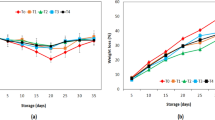Abstract
An irreversible chitosan-based indicator has been developed to monitor the kimchi quality corresponding to the partial pressure of CO2 gas in the packaging headspace. For this, 0.3% (w/v) solutions of chitosan and the Coomassie Brilliant Blue dye (BB) were mixed at volume ratios of 10:1, 10:2, and 10:5 to yield BB-incorporated chitosan-based CO2 indicators. A greater CO2 accumulation was observed for kimchi samples stored at 25°C than those stored at 15°C. Acidity measurements indicated optimal consumer satisfaction at 1 and 3 days (when the transparency measurements for the developed indicators were approximately 20%) for kimchi samples stored at 15 and 25°C, respectively. A Pearson correlation analysis revealed that the indicator transparency correlated well with several parameters used to indicate the kimchi quality.
Similar content being viewed by others
References
Ahvenainen R. Active and intelligent packaging: An introduction. pp. 5–21. In: Novel Food Packaging Techniques. Ahvenainen R (ed). Woodhead Publishing, Cambridge, UK (2003)
Heising JK, Dekker M, Bartels PV, van Boekel MAJS. A non-destructive ammonium detection method as indicator for freshness for packed fish: Application on cod. J. Food Eng. 110: 254–261 (2012)
Jang NY, Won K. New pressure-activated compartmented oxygen indicator for intelligent food packaging. Int. J. Food Sci. Tech. 49: 650–654 (2014)
Kuswandi B, Wicaksono Y, Abdullah A, Heng LY, Ahmad M. Smart packaging: sensors for monitoring of food quality and safety. Sens. Instrum. Food Qual. Saf. 5: 137–146 (2011)
Lu L, Zheng W, Lv Z, Tang Y. Development and application of time-temperature indicators used on food during the cold chain logistics. Packag. Technol. Sci. 26: 80–90 (2013)
Prasad P, Kochhar A. Active Packaging in Food Industry: A review. IOSR J. Env. Sci. Toxicol. Food Technol. 8: 1–7 (2014)
Nopwinyuwong A, Trevanich S, Suppakul P. Development of a novel colorimetric indicator label for monitoring freshness of intermediate-moisture dessert spoilage. Talanta 81: 1126–1132 (2010)
Neethirajan S, Jayas D, Sadistap S. Carbon dioxide (CO2) sensors for the agri-food industry-A review. Food Bioprocess Tech. 2: 115–121 (2009)
Ko JL, Oh CK, Oh MC, Kim SH. Isolation and identification of lactic acid bacteria from commercial kimchi. J. Korean Soc. Food Sci. Nutr. 38: 732–741 (2009)
Hong SI, Park WS. Sensitivity of color indicators to fermentation products of kimchi at various temperatures. Korean J. Food Sci. Technol. 29: 21–25 (1997)
Hong S-I, Park W-S. Use of color indicators as an active packaging system for evaluating kimchi fermentation. J. Food Eng. 46: 67–72 (2000)
Jung J, Puligundla P, Ko S. Proof-of-concept study of chitosan-based carbon dioxide indicator for food packaging applications. Food Chem. 135: 2170–2174 (2012)
Puligundla P, Jung J, Ko S. Carbon dioxide sensors for intelligent food packaging applications. Food Control 25: 328–333 (2012)
Jung J, Lee K, Puligundla P, Ko S. Chitosan-based carbon dioxide indicator to communicate the onset of kimchi ripening. LWT-Food Sci. Technol. 54: 101–106 (2013)
Mills A, Skinner GA, Grosshans P. Intelligent pigments and plastics for CO2 detection. J. Mater. Chem. 20: 5008–5010 (2010)
Wong YC, Szeto YS, Cheung WH, McKay G. Adsorption of acid dyes on chitosan-equilibrium isotherm analyses. Process Biochem. 39: 695–704 (2004)
Wan Ngah W, Teong L, Hanafiah M. Adsorption of dyes and heavy metal ions by chitosan composites: A review. Carbohyd. Polym. 83: 1446–1456 (2011)
Ravi Kumar MN. A review of chitin and chitosan applications. React. Funct. Polym. 46: 1–27 (2000)
Kim E-Y. World Institute of Kimchi as a leading global institute of fermented foods. Biotechnol. J. 8: 759–760 (2013)
Jung JY, Lee SH, Jeon CO. Kimchi microflora: History, current status, and perspectives for industrial kimchi production. Appl. Microbiol. Biot. 98: 2385–2393 (2014)
Author information
Authors and Affiliations
Corresponding author
Rights and permissions
About this article
Cite this article
Meng, X., Lee, K., Kang, TY. et al. An irreversible ripeness indicator to monitor the CO2 concentration in the headspace of packaged kimchi during storage. Food Sci Biotechnol 24, 91–97 (2015). https://doi.org/10.1007/s10068-015-0014-2
Received:
Revised:
Accepted:
Published:
Issue Date:
DOI: https://doi.org/10.1007/s10068-015-0014-2




